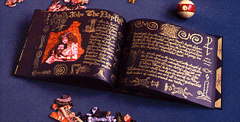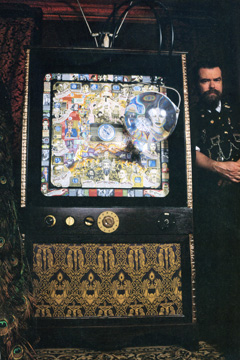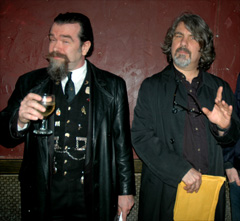|
JUXTAPOZ Issue #47, November 2003 Joe Coleman An Account of Recent Works by JOE COLEMAN, 
“JOE COLEMAN, open your heart and reveal the real you,” said the muse. And he did! Joe let it all hang out. For decades he’d soaked up awful electromagnetic effluvia: he watched too much TV!!! Filled to overflowing with America’s worst, he finally cracked. A flood of TV imagery gushed from his psyche, through his delicate hand, onto virgin masonite. Pow! A pantheon of notorious television personalities, an archive of evening-news horror, a jumble of sick cartoon characters exploded. Juxtapoz takes an up-close look — But first, these messages. Whenever you have a nightmare, or get scared to death, or get hurt real bad, or take a bad trip, welcome to Coleman’s world! Whatever you don’t want to see or feel or know surrounds you as pain, disease, and evil interact. His painting style mixes classical and home-grown, precision draftsmanship and infinitely expanded doodles, pop and folk. He’s a cross between occult visionary Hieronymus Bosch and Americana painter Thomas Hart Benton, who depicted everyday life with people bent supernaturally amidst pastoral settings. Coleman likewise depicts everyday life. However, he presents corporeal reality, real pain and suffering, awful people hurting others in profound ways. Serial killers, mass murderers, and helpless victims populate Joe’s garage of doom. They rape children, cut old women’s throats, jack off, maybe fry in the electric chair. Dreary streets and dead-end alleys replace Benton’s expansive wheatfields and Bosch’s purgatories as backdrops to the human drama. Coleman, in his late forties, ranks among the great painters. Additionally he enjoys a reputation as a performance artist and archivist of the insane. His works and collections shed light on primal passions, forbidden practices, and the sexual rush of violence. By inviting death into the bedroom, he endears himself to a masochistic nation. 
In Joe’s portraiture, iconographic renderings of notorious individuals breathe new life into morbid characters and shed new light into history’s dustbin. About his portrait of Phineas T. Barnum, the artist says, “I identify with the guy as a collector and as a hoaxster and performer. He had an appreciation of the vulgar side of life. Incidentally, Barnum’s museum and home burned down.” Joe points to flaming structures in the richly detailed background, impressively researched and technically accurate. Another portrait captures the young killer Mary Bell. The busy composition evokes backwater carnival midways, full of deadly freakshows. In the center stands Mary, sickly innocent. Joe: “That’s the little girl who was killin‘ other kids in Newcastle, England during the 60s. It’s called And a Child Shall Lead Them. The figures she’s inspiring include other young killers like Kip Kinkel and the Columbine kids. After I got married and started thinkin‘ about havin‘ kids — this painting was the kid that was produced. Her mom was a prostitute who made her suck off johns. Mary had these bloody, bruised knees from either giving blowjobs on her knees or from kneeling while she strangled other kids. She was always on her knees.” Other luminaries grace the artist’s masonite slabs: religious fanatic Boston Corbett — killer of Lincoln assassin John Wilkes Booth, kid-crazed wacko artist Henry Darger, Public Enemy Number One John Dillinger, and hard-livin‘ Hank Williams. Each portrait unveils an individual contribution to humanity’s self-destruction, about which the artist says, “It doesn’t matter who brings it on or how it happens. Because we have the ability to destroy ourselves, it will be done, not because of politics or religion or any personal reasons, but because science gave us the ability to destroy ourselves. It will be done.” Behind every great talent lies a great ego. Few artists are as enamored of their own personas as Joe. Obviously that keeps him focused. On the surface a cool guy, down below he runs a tight ship. “I can’t talk about that ’cause it’s just the basic way I feel. Hooray for me and fuck you,” he explains. His performances challenged convention, and people either loved or hated him. For example, as a geek he bit the heads off small animals. For that he got arrested. One could think of him as a prophet of hypocrisy, getting in trouble for doing the same thing exterminators and butchers do every day, or as an attention-seeking sadist with a contrived disregard for life. As a painter he kicks up controversy not only for hideous subject matter and endless self-portraits but also for his very genre. Consider his recent rejection from the New York Outsider Art Fair for not being an “outsider.” On the one hand, no one reads as more of an outsider than Joe — essentially self-taught, he comes from a psychologically isolated upbringing; on the other hand, he learned from popular styles, got published early on, and now exhibits his work in major galleries all over the world, fetching fifty grand a painting — how outsider is that? 
In a recent dispatch the artist explains, “I don't know if I'm an outsider. I don't even know if I know what an outsider is. I find it extremely ironic that after a lifetime of being excluded from the mainstream art world because my work did not conform to recent trends and polite tastes, I am now being excluded from an outsider event. In the review committee's memo concerning the banning of my work, I am described as ‘being too aware of the whole business process of selling’ my work. It makes me wonder about these anonymous, parasitic art insiders sitting on their committee, and about the fears which would cause them to make such judgments. Are we to assume that they would prefer to deal with someone who is intellectually, physically, or emotionally incapable of protecting themselves from being exploited, manipulated, hoodwinked, and/or robbed?” Right on, Joe! Books, magazine articles, scholarly investigations, and glowing reviews present repeating hagiographies of the artist. But few writers get it right because most are sycophantic, spellbound spuds scared of saying the wrong thing. To them, Joe tells his tales like an old sailor, steering beloved stories along well-worn routes. Consequently, the same anecdotes repeat throughout his press history, rehashing a select few of his artistically misanthropic adventures: blowing himself up, performing autopsies, singing for the band Steel Tips, confronting authority, enduring beatings from his old man, studying his decaying mother, digging his drug addiction (“Ain’t a drug I didn’t do”), and perfecting his darkly charming demeanor and obscene obsessions. But who exactly is the real Joe Coleman? A new work suggests he’s a Frankenstein-like amalgam constructed not from real people but from ghosts; not from the flesh-and-blood individuals who command media attention, but rather from their two-dimensional phantom representations on television. Flickering with friendly familiarity, they became real people in the young artist’s vulnerable mind. Sex, violence, advertising, and patriotism overlapped, interlocked, blended into superficiality, right and wrong losing meaning. Thus Coleman the threat to society results from society’s most exalted institution, television. Joe: a living TV, a human analog of media manipulation, a willing vehicle of subliminal seduction. 
About his latest and greatest creation, a psychic self-portrait, he says, “It’s the first painting I’ve done that’s multi-media — it’s sculptural and it has a soundtrack as well. There’s a smoke machine inside. It’s called As You Look Into the Eye of the Cyclops, the Eye of the Cyclops Looks Into You. It’s about the television. It’s an oversized version of an actual TV set. “Television is a part of me. It’s propaganda, it’s drugs, it’s sex, it’s a teacher, it’s a manipulator. All those things are part of the way I think. I’m fascinated by old movies, and even porno you watch on a TV set. Television’s your first experience with violence and sex and politics and religion and morality and reason. It’s a living being. As you look into it, it’s looking into you, deciding what you need. “So I made this painting. It’s like an altar to this modern god. You can turn on the soundtrack. The magnifying lens suspended in front of the painting is from my grandfather’s television. The knobs are from vintage sets.” The painting, in both color and black-and-white (of course!), portrays a full spectrum of seedy icons from b-movie bitches to evangelists, from Bush to bin Laden. “Seen on TV, they all become flat,” the artist says. “They all become equal. They exist on the same plane. Here’s James Cagney, who goes out in a blaze of glory at the end of White Heat even though he’s a monstrous psycho. And here’s David Koresh, who also went out in a blaze of glory in Waco, Texas, and becomes a heroic martyr even though he’s a psycho. They reflect each other. Porno and cartoons become one and the same thing.” Also in the mix: Charles Manson, Orsen Welles, Lee Marvin, Bob Barker, Joan Collins, character actors Dwight Frye, Woodrow Parfrey, and Rondo Hatton, as well as Joe’s favorite scenes of newsworthy mayhem and cheesy titillation. A series of related vignettes layed out in the style of Bosch’s Garden of Earthly Delights, Joe’s Eye of the Cyclops captures a kaleidoscopic menagerie of hard faces, sexy people, twisted bodies, and scary shit — all of it counterpoint to the much-ballyhooed majesty of America’s supreme visual vernacular! On the painting’s looping soundtrack, snippets of dialog from old movies and old shows, advertising jingles, dramatic music, and grim news bulletins segue seamlessly, compiled by the artist from the white noize endlessly oozing from boob tubes. “It’s very personal,” he says. “It’s about me growing up on television, and what an inspiration it was, and what I love about it and hate about it, and what scares me. Everything’s extremely well-researched.” Among the images: test patterns, schematics of cathode ray tubes, diagrams. But the superhuman characters take center stage. “It’s a love-hate relationship. It’s not the definitive history of television. It’s my personal history of TV. You don’t see Gilligan’s Island here. It’s about me.” Pop-culture critic Richard Metzger, who observes Joe’s evolution, comments: “With As You Look Into the Eye of the Cyclops, Coleman’s taking on a subject more abstract than one person's biography. When you consider just how far beyond what anyone else can do in that regard, he’s utterly without peer. Who could come along and knock Joe off his pedestal now? It's not gonna happen.” You said it! Next subject? Joe: “I never know until I’ve completed the piece I’m working on at the time. I try not to think about it.” Lastly, what will happen to you after departing this mortal coil? “I’ll live on forever in the work.” Few people can make that claim. Goodnight! Recently released repositories of Colemanesque splendor include the Disinformation Company’s DVD of Robert Pejo’s Rest in Pieces, a feature-length documentary on the artist’s life and work featuring appearances by Jim Jarmusch and Hasil Adkins. A coffee-table compendium published by La Luz de Jesus Press and Last Gasp contains recent paintings: The Book of Joe brings painfully magnified details to life, and explains the works’ many references. Essays by Asia Argento, Jack Sargeant, and Anthony Haden-Guest extol Joe’s artistic virtues.  Joe Coleman & George Petros LIT Lounge, NYC 2005 |
||||||||||||||||